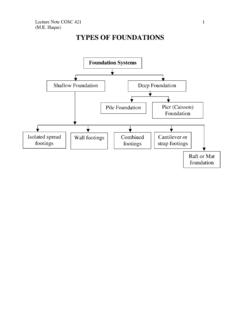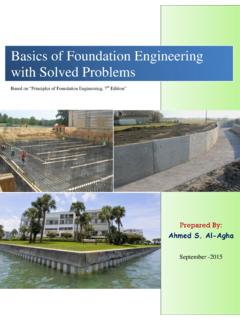Transcription of Structual Design of Utility Distribution Poles and Light Poles
1 Special Research Topic Report on Current Practice in Utility Distribution Poles and Light Poles Adam CrosbyDate 5/05 ObjectiveThe objective of this report is to present a summary of the current practice of the structural Design ofutility Distribution Poles and Light Poles , including the Poles and foundations . This summary includesdesign and safety standards and codes, material specification, material selection, foundation Design , Design liability, and maintenance. Two common genres of Poles are discussed in this report. The first genre is Utility Poles . Utility polesare grouped into two kinds Utility transmission and Utility Distribution .
2 The second genre includes polesfor lighting, traffic, homeland security, and intelligent traffic structures. The two genres of Poles areanalyzed and designed by the same structural principles, but they differ in governing codes and commonindustry practice. This report focuses on Poles for Utility Distribution and lighting. Because they of theirdifferences, they are treated as two separate topics in this report. The first section of the report addressesutility Distribution Poles and the second section addresses Poles used for lighting. Utility Poles and StructuresUtility Poles often support wires and other components for many utilities such as electric power,telecommunications, cable television, and fiber optic.
3 Transmissionlines typically carry the electric power from the source to substationswhere Distribution lines branch off to supply the surroundingbusinesses and homes with power. Figure 1 shows a typicaltransmission structure. In some cases there is difficulty in making adistinction between Utility transmission lines and Utility distributionlines. Distribution lines can best be distinguished from transmissionlines by their smaller rights-of-way. In addition to having taller polesand structures, a transmission line is accompanied by rights-of-wayranging from 75-200 feet and voltages around or above 69 kV.
4 (RUSB ulletin 1724E-20). Regarding Utility Poles ,this report focuses on Distribution . See Figure4 for a typical Distribution Lighting, Traffic, and HomelandSecurityFrom the genre of Poles including lighting,traffic, and homeland security, this reportfocuses only on lighting. Light Poles aretypically freestanding Poles with Light fixturesat the top. Figure 2a shows a typical Light 1: TransmissionStructure (Crosby, 2011)Figure 2: a) Light pole , b)Traffic Mast Arm pole (aand b from )Traffic Poles include those supporting traffic signals and signs as shown in Figure of homeland security and intelligent traffic structures are message signs, surveillance cameras, andtraffic sensors.
5 See Figure 3 for 3: a) Message Sign, b) Surveillance pole , c) Surveillance pole with solar panels (a, b, and cfrom ) Utility Distribution Poles Utility Distribution Poles , sometimes called power Poles or telephone Poles , are components indistribution lines. Other components include various Utility wires spanningfrom Poles to pole , guy wires, transformers and other equipment. Figure 4shows a typical wood Distribution pole . Types of Utility CompaniesFour types of Utility companies are involved in the ownership, Design ,installation, and maintenance of Distribution lines:1. Investor Owned Utility (IOU) such as the Southern Companywhich includes Georgia Power.
6 2. Electric Membership Cooperatives (EMC)3. Municipalities- Cities or counties providing electricitydistribution. 4. Telecommunication Companies AT&T, Verizon, Sprint, 5 shows the assigned service areas for Georgia Power, Electric Membership Cooperatives, andMunicipalities. Note that very few Poles are owned, designed, or installed by telecommunication Investor Owned Utilities Investor owned utilities are a type of Utility company owned by private investors for profit. Currently theonly investor owned Utility in Georgia is The Southern Company, which includes Georgia Georgia Power has supplied over 50% of the residential, commercial, and industrialcustomers and ( ).
7 Figure 4 Typical WoodDistribution pole (Bingel,2011)Page 2 of Electric cooperativesForty-three electric cooperatives, also known as electric membership corporations, coops, or EMCsservice 73% of the land area of Georgia. These member-owned Utility companies serve a little less than50% of Georgia's residential customers and about 13% of Georgia's commercial and industrial customerscombined. See Figure 5 for a map of EMC service. Most electric cooperatives receive funding in the form of loans from the Rural Utilities Service (RUS).Because of this, the borrowers (EMCs) are required to adhere to the Rural Utilities Service guidelines inaddition to the governing codes.
8 Figure 5: Assigned service areas by Utility company type ( )Page 3 of Municipalities In the early 1900's Georgia Power, then called Georgia Railway, was not able to build Distribution would build coal fired or oil powered power plants to supply their area with electricity and longerpower lines with no nearby towns were owned and operated by electric cooperatives. In Georgia, thereare currently (2011) 52 electric cities municipalities that own and operate their own electric distributionsystems. The number of electric cities in Georgia remains virtually constant. It would be difficult for acity such as Macon, which is not an electric city, to become one.
9 A city would have to buy the existingelectric Distribution system from Georgia Power. Because of money and politics, it is unlikely thatGeorgia Power would make this transaction. The same reasons keep electric cities in the electricitybusiness. Figure 6 shows all 52 of these electric cities. Figure 6 Map of Municipalities providing their own power (A. Crosby and Google Maps, 2011)While some of these cities have large enough engineering departments to Design most or all of their owndistribution Poles , the majority rely on private consulting engineers or an organization called ElectricalCities of Georgia (ECG).
10 ECG is a not for profit organization that provides engineering services andsafety training. Currently, almost all of the 52 electric cities subscribe to Electrical Cities of Georgia'straining, engineering services, or both. The majority of these subscribe to ECG's engineering services todesign some or all of their Distribution lines. Page 4 of Telecommunications A very small percentage of the Utility Distribution Poles in Georgia are owned, designed, and maintained by telecommunication companies like AT&T, Verizon, Sprint, and Cox. When a Utility pole carries only telephone line, the telecom company most likely owns and operates it.





![Pile Foundation Design[1] - ITD](/cache/preview/7/1/b/5/4/9/2/e/thumb-71b5492ea36fbc0a87c29e49c6fa8bff.jpg)



